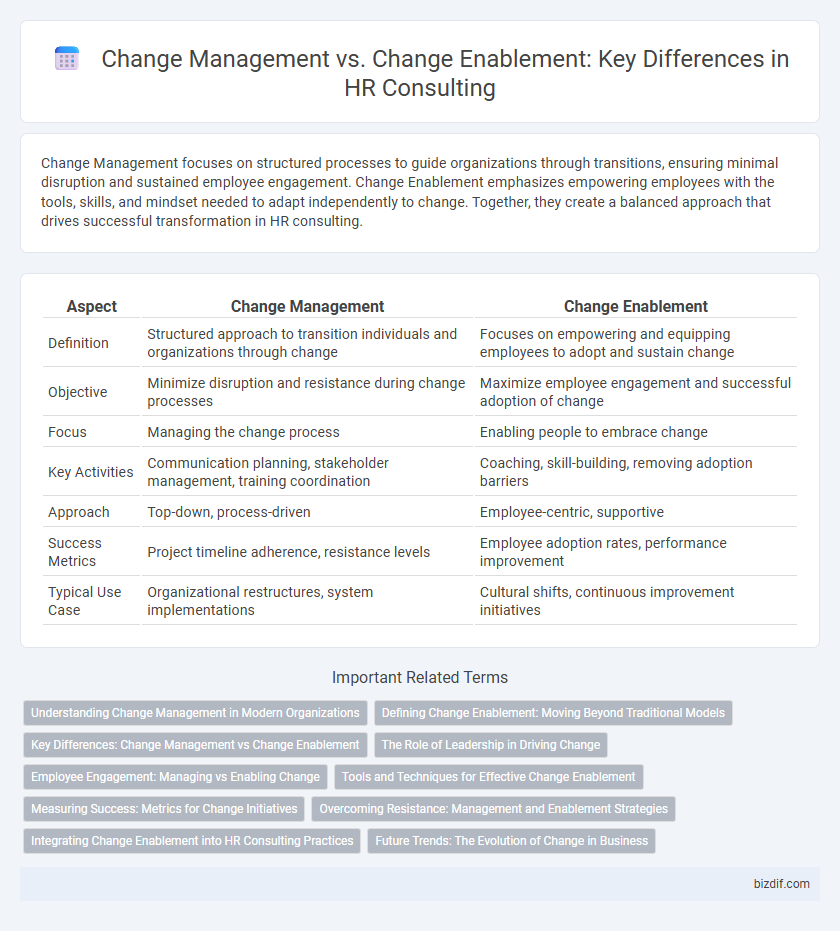Change Management focuses on structured processes to guide organizations through transitions, ensuring minimal disruption and sustained employee engagement. Change Enablement emphasizes empowering employees with the tools, skills, and mindset needed to adapt independently to change. Together, they create a balanced approach that drives successful transformation in HR consulting.
Table of Comparison
| Aspect | Change Management | Change Enablement |
|---|---|---|
| Definition | Structured approach to transition individuals and organizations through change | Focuses on empowering and equipping employees to adopt and sustain change |
| Objective | Minimize disruption and resistance during change processes | Maximize employee engagement and successful adoption of change |
| Focus | Managing the change process | Enabling people to embrace change |
| Key Activities | Communication planning, stakeholder management, training coordination | Coaching, skill-building, removing adoption barriers |
| Approach | Top-down, process-driven | Employee-centric, supportive |
| Success Metrics | Project timeline adherence, resistance levels | Employee adoption rates, performance improvement |
| Typical Use Case | Organizational restructures, system implementations | Cultural shifts, continuous improvement initiatives |
Understanding Change Management in Modern Organizations
Change Management in modern organizations involves structured processes to guide employees through transitions, minimizing resistance and maximizing adoption by addressing the human side of change. Unlike Change Enablement, which focuses on equipping individuals with tools and capabilities to adapt proactively, Change Management emphasizes strategic planning, communication, and leadership alignment to ensure successful implementation of organizational changes. Understanding these distinctions helps HR consultants design targeted interventions that align with organizational goals and workforce dynamics.
Defining Change Enablement: Moving Beyond Traditional Models
Change enablement redefines organizational transitions by emphasizing employee engagement and continuous support rather than simply executing planned changes. It integrates behavioral insights and real-time feedback to adapt strategies dynamically, fostering resilience and sustained adoption. Unlike traditional change management, change enablement promotes a holistic, participative approach that accelerates transformation success.
Key Differences: Change Management vs Change Enablement
Change Management focuses on structured processes and strategies to guide organizations through transitions, emphasizing risk mitigation and compliance. Change Enablement prioritizes empowering employees and fostering a culture of adaptability, promoting continuous engagement and collaboration throughout transformations. The primary difference lies in Change Management's top-down approach versus Change Enablement's people-centric, agile methodology that drives sustainable change.
The Role of Leadership in Driving Change
Leadership plays a critical role in both change management and change enablement by setting vision, aligning teams, and fostering a culture receptive to transformation. Effective leaders prioritize transparent communication and empower employees to embrace new processes, ensuring smoother adoption and sustained organizational growth. Strong leadership commitment accelerates change initiatives, reduces resistance, and drives measurable performance improvements.
Employee Engagement: Managing vs Enabling Change
Change Management focuses on directing employees through structured processes to minimize resistance and ensure compliance during organizational transitions. Change Enablement emphasizes empowering employees by fostering collaboration, autonomy, and continuous feedback to drive proactive adaptation and sustained engagement. Prioritizing Change Enablement enhances employee commitment, accelerates adoption, and strengthens overall organizational resilience.
Tools and Techniques for Effective Change Enablement
Effective change enablement leverages advanced tools such as digital collaboration platforms, real-time feedback systems, and data analytics to monitor employee engagement and identify resistance early. Techniques like agile change frameworks, interactive training modules, and stakeholder mapping ensure tailored communication and continuous support throughout the transition. These methods outperform traditional change management by fostering adaptability and empowering employees to drive sustainable organizational transformation.
Measuring Success: Metrics for Change Initiatives
Measuring success in change management hinges on key performance indicators like employee adoption rates, stakeholder engagement levels, and the achievement of defined business outcomes. Change enablement emphasizes real-time feedback loops, training completion rates, and behavioral change metrics to ensure sustainable transformation. Both approaches require robust data analytics to quantify impact, track progress, and refine strategies for continuous improvement.
Overcoming Resistance: Management and Enablement Strategies
Overcoming resistance in change management involves structured communication plans, employee training, and leadership buy-in to address concerns and reinforce the change's benefits. Change enablement focuses on empowering employees through tools, resources, and ongoing support to build confidence and adaptability. Combining management strategies with enablement techniques accelerates adoption and minimizes disruption during organizational transformations.
Integrating Change Enablement into HR Consulting Practices
Integrating Change Enablement into HR consulting practices enhances organizational agility by focusing on employee engagement, communication strategies, and continuous support throughout the transition process. Unlike traditional Change Management, Change Enablement emphasizes proactive involvement, empowering employees to adopt new processes and technologies seamlessly. HR consultants leverage tools like stakeholder analysis, change impact assessments, and tailored training programs to drive sustainable behavioral change and improve overall business performance.
Future Trends: The Evolution of Change in Business
Change enablement emphasizes continuous employee engagement and adaptive learning, integrating digital tools and AI-driven insights to personalize transformation journeys. Future trends reveal a shift from traditional change management's top-down directives toward decentralized, agile frameworks that foster collaboration and resilience in complex business environments. Organizations leveraging real-time analytics and immersive technologies gain a competitive edge by accelerating adoption and minimizing disruption during change initiatives.
Change Management vs Change Enablement Infographic

 bizdif.com
bizdif.com